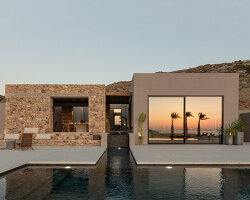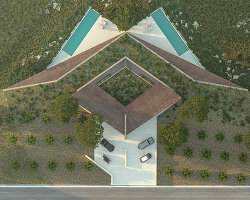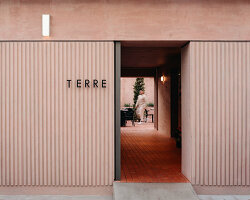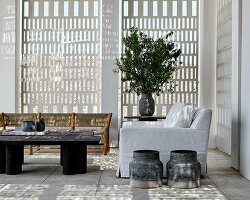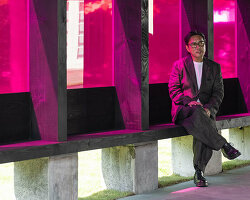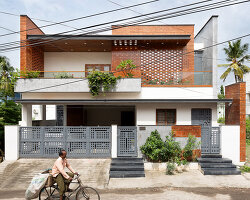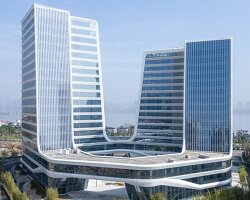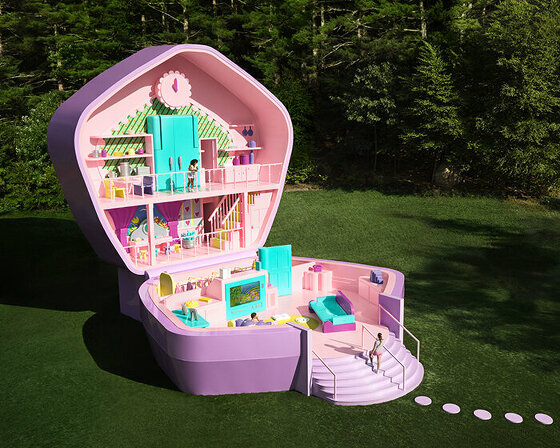STUDIO VISIT TO Athens-based block722 ARCHITECTS
Block722 is an Athens-based architecture studio that was founded in 2009 by Greek architect Sotiris Tsergas and Swedish-born interior designer Katja Margaritoglou. With a diverse portfolio ranging from homes and hotels on Greek islands to residential developments in the Caribbean, the studio combines Greek and Scandinavian heritage along with interdisciplinary expertise. Their design philosophy revolves around incorporating quality materials, a crafts-based approach, and collaborations with local artisans and artists to interpret the Mediterranean spirit and traditions for the 21st century. Their aim is to create projects that exude a sense of confidence, natural harmony, and timelessness.
designboom visited Block722’s new headquarters at Ardittou street in central Athens, and caught up with its founders to delve deeper into the practice’s origins, identity, and creative process. ‘In each of our projects, we always start from a new foundation, and along the way, we may bring common elements that are part of our identity,’ explains Margaritoglou. ‘Each place has its own distinct identity, and we strive to discover and adopt as many elements and information as possible to incorporate them into our creations,’ shares Tsergas. ‘We also attach great importance to the clients. We want to learn about their habits, lifestyle, family situation, routine, and personal interests,’ he adds. Read the interview in full, below.

Block722 headquarters in Athens | image by George Sfakianakis
Interview with founders Sotiris Tsergas & Katja Margaritoglou
designboom (DB): How did your collaboration begin?
Katja Margaritoglou (KM): Our collaboration actually began as a couple. After going on a few dates, we realized that we were both working in the same field. Initially, we were working separately, as Sotiris already had his own office. However, our relationship and professional journey naturally evolved and that’s what truly defines our collaboration. Although we encountered some minor challenges initially, we quickly found our rhythm. Eventually, we opened our first shared office on Patision Street, in the center of Athens.
Sotiris Tsergas (ST): When I met Katja and our conversations took a more professional turn, I discovered the stark differences in our backgrounds, despite working within the same field. Architecture and design reign supreme in my world. Suddenly, Katia entered the picture and introduced me to the concept of a more holistic experience, like how materials and colors can harmonize with the environment. This aspect was initially challenging for me to grasp and somewhat dismantled the foundations I had built over the years, as those were my primary references and the path I had chosen for my architectural evolution. Thus, two different worlds collided, and this led to the creation of BLOCK722.

Block722 founders Katja Margaritoglou and Sotiris Tsergas | image by Yiorgos Kaplanidis
DB: Katja, where did you grow up, and how does that influence the identity of the studio?
KM: I grew up in Sweden and after school, I came to Greece. For many years I worked in the fashion industry, but at the same time, I started thinking about interior design. It was like a need that began to occupy my mind. Even as a child of parents who had no connection to design, during my upbringing in Sweden, aesthetics and balance were everywhere. When I came to Greece, I realized that this field interested me, and I wanted to explore it further. So I began my studies, although it doesn’t mean that school provides you with everything. After studying, you feel like you don’t know anything (and sometimes I still feel that way), but the good thing is that opportunities are given to you. Slowly, you build your portfolio. There is no security in education here, but you have to be the one who seeks the knowledge you need. However, I carry Swedish and Scandinavian elements with me, and that characterizes our projects. Sometimes the Mediterranean aesthetics and emotional disposition are emphasized more, but there are definitely references to the Scandinavian style as well.
ST: When we started, there was no specific plan. It was just Sotiris and Katja, and each of us brought our own knowledge. However, this knowledge intertwined and evolved. And of course, we also evolved through our collaborations. Thus, over time, the office evolves, not only through Sotiris and Katja, but also through the many people who grew with us and from whom we draw references. Our emotions and experiences have helped us build our identity.

Block722 headquarters in Athens | image by George Sfakianakis
DB: Do you feel a need for evolution and deepening in your projects?
KM: Lately, I’ve been wavering between evolution and familiarity. There are many forms of evolution. One of them is to delve deeper into the subject itself. To explore every aspect of wood, for example. There are so many specific things that you can delve into, improve, and evolve. As you mature and develop, you have the need to subtract. In each of our projects, we always start from a new foundation, and along the way, we may bring common elements that are part of our identity. But our need is to start with fresh information, giving great importance to the place and the client. The place is something that constantly influences and challenges us.
ST: We seek diversity through the integration of multiple elements of the place into our projects. Each place has its own distinct identity, and we strive to discover and adopt as many elements and information as possible to incorporate them into our creations. This alone makes our projects unique. We also attach great importance to the client. We want to learn about their habits, lifestyle, family situation, routine, and personal interests. If it’s a hotel, we encourage clients to help us create the image of the ideal guest. In this way, we personalize the experience and offer customized solutions. It is clear that we should not constantly follow trends but rather delve deeper into the things we know well. We seek the details that may not be visible at first glance but are understood over time by those who experience the space. This gives a timeless quality to our projects. Both the place and the client are becoming increasingly important to us.
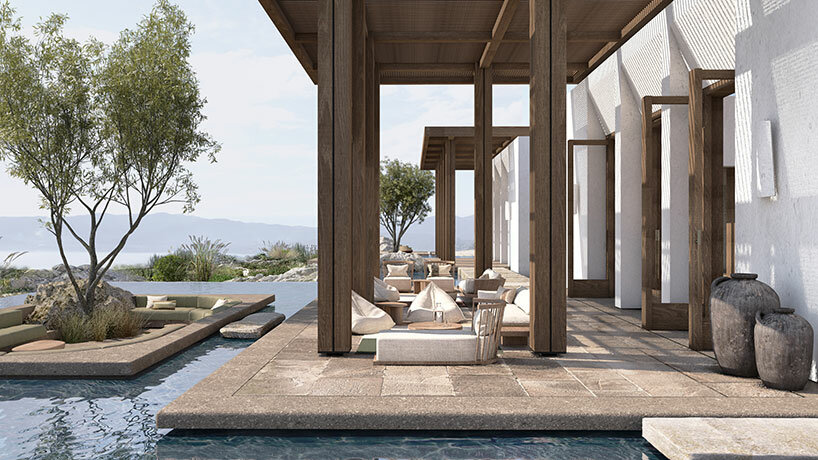
hotel in Crete | image courtesy of Block722
DB: You often engage in collaborations with local artists and craftsmen to bring your projects to fruition. Is it something you explore depending on the project, or do you have a standard team of people you work with?
KM: We are excited to collaborate with individuals who share the same passion as us for creation and innovation. These collaborations are particularly creative and contribute a lot to our work. As we seek inspiration and ideas, we look to other locations and contemplate how we can express ourselves differently and adapt to our environment.
ST: We undertake many projects abroad and in different places, so it’s impossible for us to have a stable team. But when we create something of our own, like furniture, we want to have specific individuals to closely collaborate with. By working worldwide, we have developed skills related to understanding the craftsman and the person immediately, and cultivating flexibility, so that we can get the best possible outcome. Thus, in our projects that combine different cultures and locations, we choose craftsmen with whom we have a closer connection, especially when it comes to furniture design or custom-made pieces.

Block722’s headquarters in Athens features Spring Lilies (2021) by Greek artist Pantelis Chandris (left) | image by George Sfakianakis
DB: Are there any examples where collaboration, either with an artist or a craftsman, contributed in some way to add further value to your work?
ST: When we were working on a project in the eastern part of Crete, we collaborated with local craftsmen, from carpenters to stonemasons, to mosaic and marble specialists. These people had their own techniques and tools, and as we spent time with them, we had the opportunity to see the process through their expertise and technical training. During the collaboration, we conducted a study that served as our guide, and then followed a time-consuming work by these individuals.

O Lofos residence in Crete, image by Ana Santl | discover the project here
KM: Currently, we are collaborating with a very creative woman who is exceptional in the art of embroidery. She is full of inspiration and enthusiasm, and as a result, we have created many works together. For example, we created a large artwork, measuring three meters by two and a half meters.
This piece required many hours of work. It originated from the client’s roots, as they had a special emotional connection to them. We visited the space many times to see it together, repeatedly and always with great eagerness. Facing countless limitations pushes us to think creatively, and that excites us.
ST: In general, the whole process of designing furniture or objects is born out of the work itself. The willingness we have with craftsmen to create functional objects emerges through the evolution of a project. And each time, it gives us something different. Some parts of a project may seem simple from the outside, but if you experience the space, you understand that all the materials are interconnected and have a reason for being there. We’re seeking a sensation as if you’re ‘seeing it without seeing it.’ It’s not deliberate; it becomes part of the project.

Block722 headquarters in Athens | image by George Sfakianakis
DB: Do you have a scale that is ideal for you to work on or that better contributes to the development of projects?
KM: When the project is located on an island, I immediately feel joy! We have the opportunity to interact with various elements such as the sun, light, air, and sea, and their limitations help us create something truly unique. We have carried out several projects, especially abroad, and each time we get many impressions from the landscapes and customs of the places where we work. However, the Mediterranean quality that characterizes our work is known even outside Greece, and Mediterranean influences are often requested. The logic remains the same, but the location, weather conditions, customs, and of course, the materials we use, change. Certainly, residential projects and hotels are our favorite projects, as they incorporate the concept of the user and serve as a new tool for creation each time.
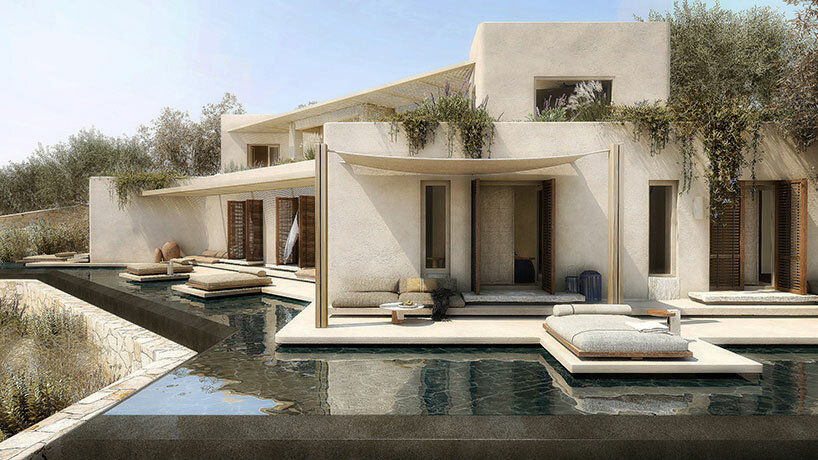
residence in Syros | image courtesy of Block722
ST: We undertake projects ranging from master planning to creating a piece of furniture, which creates a great balance in the office. It’s impressive how a team can dedicate the same amount of time to designing 60 villas and similarly a much smaller project such as a kitchen in a house. There is a play and alternation with the scales of the projects. While we are designing a massive development in Tenerife covering an area of 56,000 square meters, we also design something on a much smaller scale, like a faucet.
In Curaçao, in the Caribbean, we are constructing three developments. It is a challenge to work in an area with construction difficulties but with fantastic natural landscapes and natural beauty. To talk about Greece again, we are building a hotel in Chania, Crete, which will be ready in 2025. Additionally, in Syros, we are collaborating with the same client for whom we did our first recognizable project. It’s nice to collaborate with the same people anew after ten years. Through this experience, you can see how you have evolved and observe your own journey.

residences in Curacao | image courtesy of Block722, 3D visual by Duee studio

Block722 headquarters in Athens | image by George Sfakianakis
DB: Some of your projects have taken on a lot of recognition and have been published on various platforms. Are there cases where clients request exactly the same design or something similar? If so, how do you approach these?
ST: Yes, this happens very often. I had a client who had seen a project in Mykonos and asked us to build the same house in Abu Dhabi. This would mean taking the entire design as it is and simply constructing it again in the desired location. Obviously, we responded negatively to this request. Such a residential project takes two to four years to develop. It involves communication with the client, design, permits, and construction plans, and will be completed after a few years, depending on the size and progress of the project.
When a project is published in magazines after a period of time and a client sees it and says, ‘I want something like this,’ then we start from scratch and revise the project in the span of another 3 years. It is a shame to limit ourselves to something that was designed five years ago and promote it again to a new client just because they liked it. References are great, but we always move towards something new, something different. It is important not to confine ourselves to an aesthetic that is familiar to clients and familiar to us, and not to become fixated on the same things, but always start with new variables.

Block722 headquarters in Athens | image by George Sfakianakis

Block722 headquarters in Athens | image by Maria Siorba

Block722 headquarters in Athens | image by Maria Siorba

Block722 headquarters in Athens | image by Maria Siorba

Block722 headquarters in Athens | image by George Sfakianakis

Block722 headquarters in Athens | image by George Sfakianakis



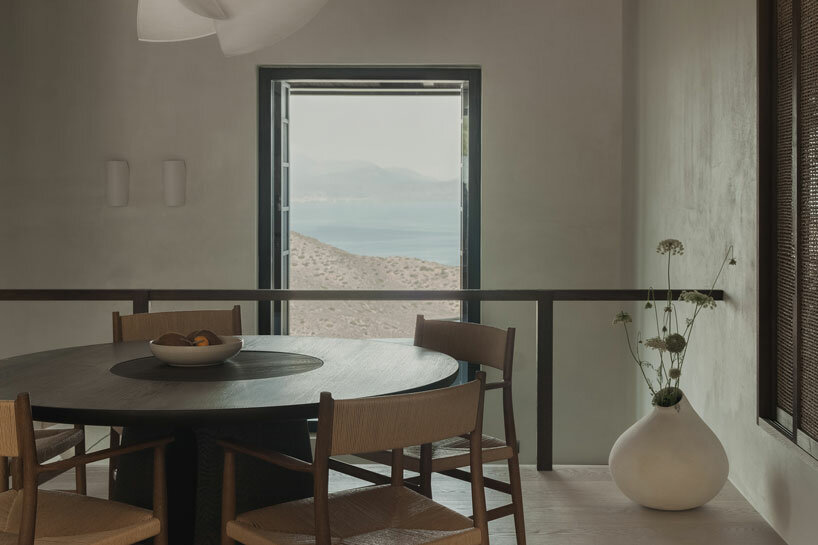
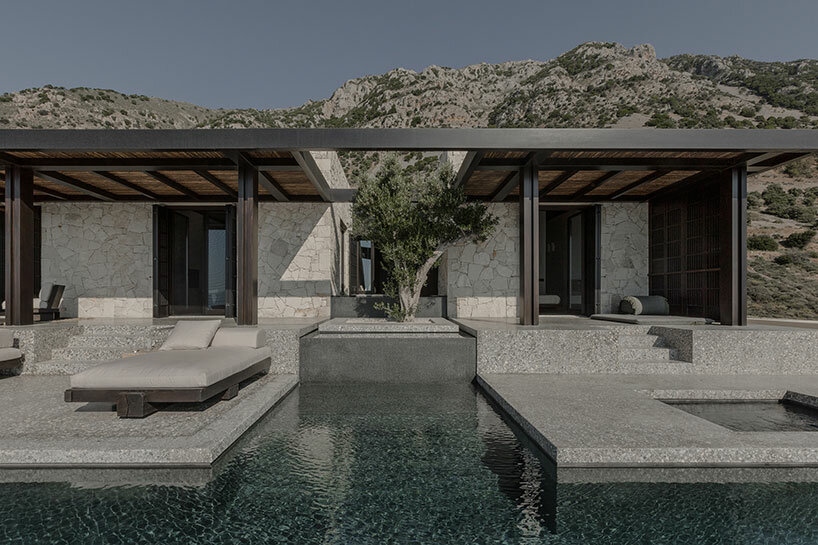




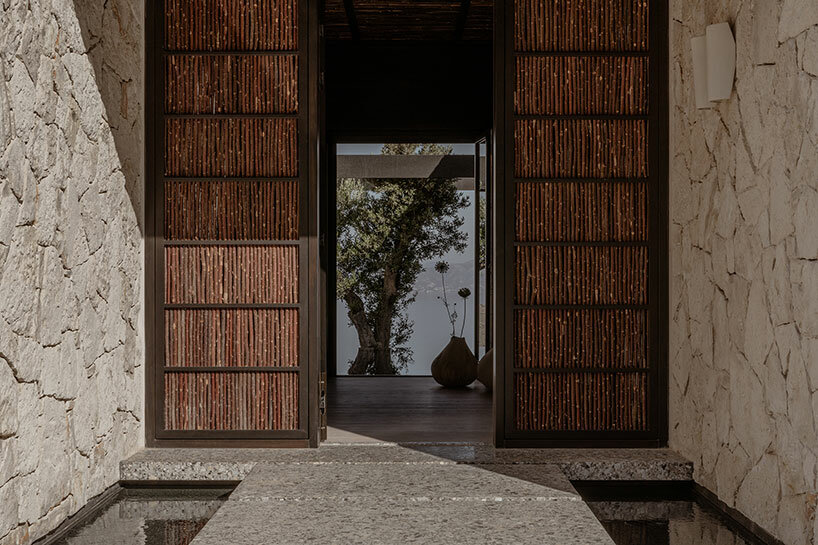
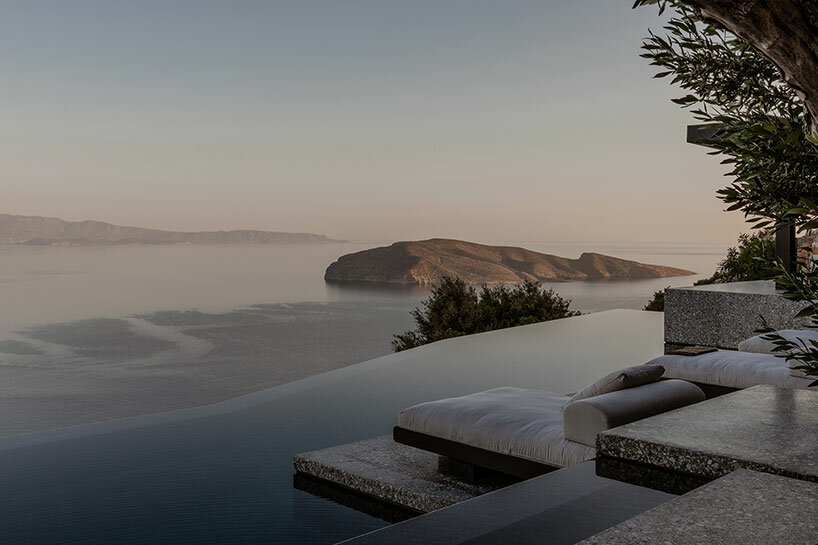





project info:
name: Block722 headquarters
architects: Block722 | @block722architects
location: Patision Street, Athens, Greece
architecture in greece (258)
architecture interviews (268)
block722 (8)
hotel architecture and design (686)
residential architecture and interiors (4037)
studio visits (112)
where people work (878)
PRODUCT LIBRARY
a diverse digital database that acts as a valuable guide in gaining insight and information about a product directly from the manufacturer, and serves as a rich reference point in developing a project or scheme.

